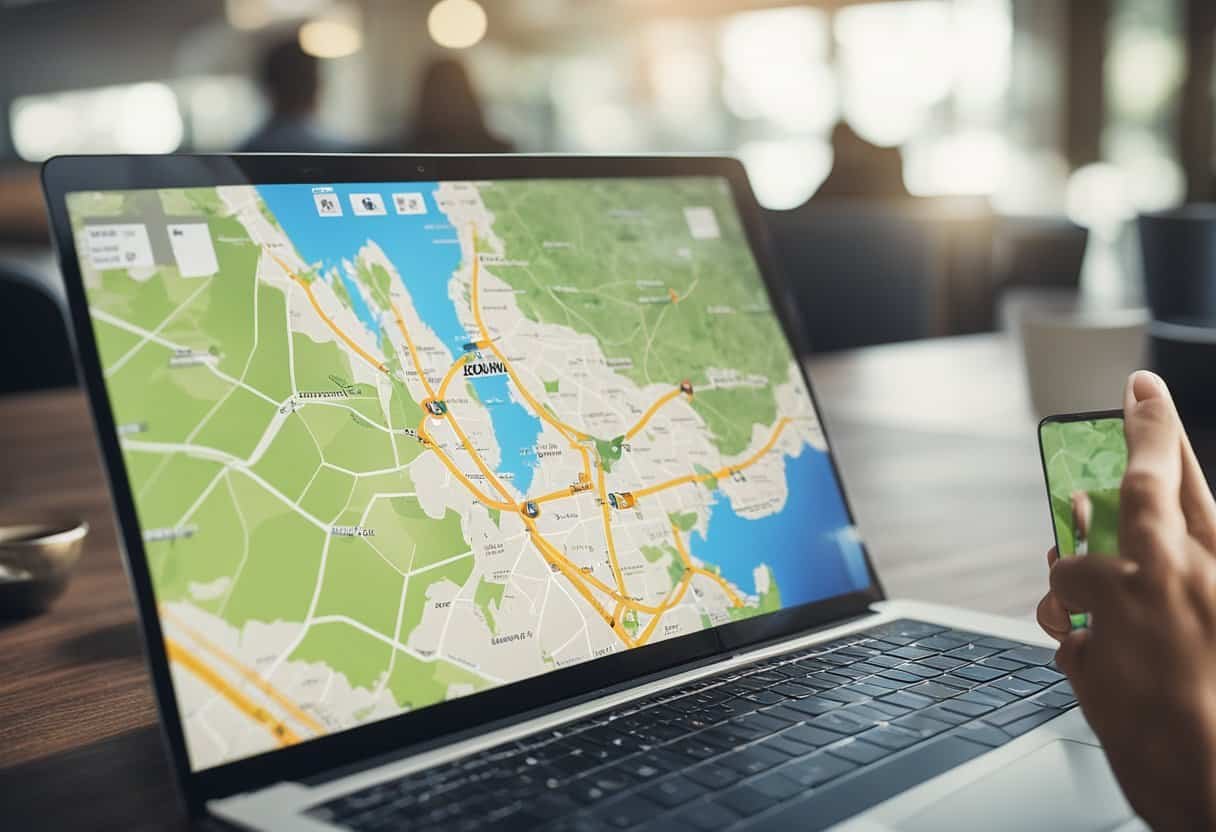If you’ve ever used a GPS app to navigate to a destination, you’ve interacted with mobility data. Mobility data is a type of data that records how people and technologies interact with their surroundings. It includes footfall, catchment regions, dwell-time analysis, and customer journey mapping, among other things. Footfall is the number of people entering a specific location, like a business, during a particular period of time. Catchment regions are the areas from which people come to visit a particular location, while dwell-time analysis measures how long people stay in a particular location.

Mobility data is collected in a variety of ways, including GPS, Wi-Fi, and Bluetooth. This data can be used to understand how people move through a city, how they interact with businesses and other locations, and how they use public transportation. Mobility data is particularly useful for urban planners, transportation officials, and businesses looking to optimize their operations. By understanding how people move through a city, officials can make better decisions about where to build new infrastructure, while businesses can use mobility data to optimize their marketing and advertising efforts.
Key Takeaways
- Mobility data records how people and technologies interact with their surroundings.
- Mobility data is collected in a variety of ways, including GPS, Wi-Fi, and Bluetooth.
- Mobility data is particularly useful for urban planners, transportation officials, and businesses looking to optimize their operations.
Understanding Mobility Data
Mobility data is a type of data that provides information about human mobility and movement patterns. It is collected through various sources, including GPS data, mobile phone data, and other location-based technologies. Mobility data is valuable because it can help us understand how people move around and interact with their surroundings.
One of the primary uses of mobility data is in transportation planning. By analyzing movement data, transportation planners can identify traffic patterns and congestion points, which can help them develop more efficient transportation systems. Mobility data can also be used to optimize public transportation routes, improve traffic flow, and reduce environmental impact.
Mobility data can also be used in public health research. During the COVID-19 pandemic, for example, mobility data was used to track the movement of people and identify potential hotspots for the virus. By analyzing movement data, public health officials were able to make more informed decisions about how to control the spread of the virus.
Another important use of mobility data is in marketing and advertising. By understanding movement patterns, businesses can identify areas with high foot traffic and target their advertising efforts accordingly. Mobility data can also be used to identify potential customers and develop more effective marketing strategies.
Overall, mobility data is a valuable tool for understanding human movement patterns and developing more efficient transportation systems, improving public health, and developing more effective marketing strategies. By analyzing mobility data, we can gain insights into how people move around and interact with their surroundings, which can help us make more informed decisions about how to improve our communities.
Sources of Mobility Data
Mobility data is collected from various sources, including private companies, open-source tools, and devices. In this section, we will discuss each of these sources in more detail.
Private Companies
Private companies are one of the primary sources of mobility data. These companies collect data from various sources, including GPS-enabled devices, mobile apps, and other location-based services. They then use this data to provide insights into consumer behavior, traffic patterns, and more.
Some of the leading private companies in the mobility data space include Safegraph, Arity, and Unacast. These companies collect data from a variety of sources, including mobile devices, connected cars, and IoT devices. They then use this data to provide insights into consumer behavior, traffic patterns, and more.
Open-Source Tools
Open-source tools are another source of mobility data. These tools are typically developed by the community and are freely available for anyone to use. Some of the most popular open-source tools for mobility data include OpenStreetMap, GeoServer, and QGIS.
These tools allow users to collect and analyze mobility data from a variety of sources, including GPS-enabled devices, mobile apps, and other location-based services. They also provide a range of features for data visualization, analysis, and sharing.
Devices
Devices are another source of mobility data. These include GPS-enabled devices such as smartphones, tablets, and smartwatches. They also include IoT devices such as connected cars and other sensors.
These devices collect data on the location and movement of individuals and objects. This data can then be used to provide insights into consumer behavior, traffic patterns, and more. However, it is important to note that the collection of this data is subject to privacy laws and regulations.
In conclusion, mobility data is collected from a range of sources, including private companies, open-source tools, and devices. Each of these sources provides unique insights into consumer behavior, traffic patterns, and more. By leveraging this data, businesses and governments can make more informed decisions about transportation and mobility.
Formats and Tools for Mobility Data

Mobility data comes in various formats, which can be used to extract valuable insights and make data-driven decisions. In this section, we will explore some of the most common formats and tools used for mobility data analysis.
Formats
Mobility data can be stored in various formats, including CSV, JSON, XML, and SQL. CSV (comma-separated values) is a simple format that stores data in a table-like structure, with each row representing a record and each column representing a field. JSON (JavaScript Object Notation) is a lightweight format that is easy to read and write, making it popular for web applications. XML (Extensible Markup Language) is another format that is widely used for data exchange between different systems. SQL (Structured Query Language) is a language used to manage relational databases and can be used to store and retrieve mobility data.
Tools
There are several tools available for working with mobility data, including APIs, data visualization tools, and machine learning libraries. APIs (Application Programming Interfaces) allow developers to access mobility data from different sources and integrate it into their applications. Data visualization tools, such as Tableau and Power BI, can be used to create charts and graphs that help visualize mobility data trends. Machine learning libraries, such as scikit-learn and TensorFlow, can be used to build predictive models based on mobility data.
Charts and Heat Maps
Charts and heat maps are powerful tools for visualizing mobility data. Charts can be used to show trends over time, while heat maps can be used to show the density of mobility patterns in different areas. For example, a heat map can be used to show the busiest areas in a city during rush hour, while a chart can be used to show the number of trips taken by different modes of transportation over time.
In conclusion, mobility data comes in various formats, and there are several tools available for working with it. By using APIs, data visualization tools, and machine learning libraries, you can extract valuable insights from mobility data and make data-driven decisions. Charts and heat maps are powerful tools for visualizing mobility data trends and patterns, helping you to better understand the movement of people and goods in different areas.
Applications of Mobility Data
Mobility data has a wide range of applications in various fields. In this section, we will explore some of the most significant applications of mobility data.
Urban Planning
Mobility data can be used to inform urban planning decisions, such as site selection for new developments and transportation planning. By analyzing mobility data, you can gain insights into how people move around a city and where they go. This data can help city planners optimize transportation systems, improve walkability, and plan for future infrastructure needs. For example, cities can use mobility data to determine the most efficient routes for public transportation or to identify areas where bike lanes would be most beneficial.
Transportation
Mobility data is also useful for transportation companies, such as ride-sharing services and scooter companies. By analyzing mobility data, these companies can optimize their pricing and improve their service offerings. For example, ride-sharing services can use mobility data to determine the most popular pick-up and drop-off locations, as well as the most efficient routes. Scooter companies can use mobility data to identify areas with high demand for their services and to optimize their fleet management.
Sales and Retail
Mobility data can also be used by sales and retail companies to inform their site selection and pricing strategies. By analyzing mobility data, these companies can gain insights into footfall data and identify areas with high foot traffic. This data can help retailers optimize their store locations and pricing strategies. For example, retailers can use mobility data to determine the most popular shopping destinations and to adjust their pricing based on demand.
Public Health
Mobility data has become increasingly important in public health, particularly during the COVID-19 pandemic. By analyzing mobility data, public health officials can track the spread of the virus and identify areas with high infection rates. This data can help inform public health policies, such as social distancing measures and contact tracing efforts. For example, mobility data can be used to track the movement of people who have tested positive for COVID-19 and identify potential exposure risks.
Overall, mobility data has significant potential in a wide range of applications, from urban planning to public health. By leveraging this data, organizations can gain valuable insights into how people move and interact with their environment, which can inform decision-making and improve outcomes.
Analyzing Mobility Data
When it comes to analyzing mobility data, there are several approaches you can take. Here are a few sub-sections to consider:
Demographic Analysis
One of the most common ways to analyze mobility data is by demographics. By looking at age, race, and other demographic factors, you can gain insights into how different groups of people move around. For example, you might find that older adults tend to travel less frequently and stay closer to home, while younger adults are more likely to travel longer distances. This information can be useful for transportation planning, marketing, and more.
Directional Analysis
Another way to analyze mobility data is by looking at the direction of travel. By analyzing the patterns of movement between different locations, you can gain insights into how people move around a city or region. For example, you might find that there is a lot of traffic moving in one direction during rush hour, which can help you plan transportation infrastructure and traffic management strategies.
Machine Learning and AI
Finally, machine learning and AI can be used to analyze mobility data in more sophisticated ways. By using algorithms to identify patterns and trends in the data, you can gain insights that would be difficult or impossible to uncover manually. For example, you might use machine learning to predict traffic congestion based on historical data, or to identify areas where new transportation infrastructure is needed.
Overall, analyzing mobility data can provide valuable insights into how people move around and interact with their environment. By using demographic analysis, directional analysis, and machine learning and AI, you can gain a deeper understanding of these patterns and use that information to inform transportation planning, marketing, and other important decisions.
Challenges and Solutions

Mobility data has become an essential tool for businesses, governments, and researchers. However, it comes with its fair share of challenges. In this section, we will discuss some of the challenges and solutions related to mobility data.
Privacy Concerns
One of the primary challenges with mobility data is privacy concerns. Mobility data is often collected from mobile devices, such as smartphones, which can track a user’s location, movements, and behavior. This data can be sensitive and personal, raising concerns about privacy and data protection.
To address these concerns, policymakers and businesses must ensure that mobility data is collected and used in a transparent and ethical manner. This can include obtaining explicit user consent, anonymizing data, and implementing robust security measures to protect sensitive information.
Data Complexity
Another challenge with mobility data is its complexity. Mobility data is dynamic and constantly changing, making it challenging to analyze and interpret. It can also be difficult to integrate different types of mobility data, such as public transit data, traffic data, and pedestrian data.
To overcome these challenges, businesses and researchers can use advanced data analysis tools and techniques, such as machine learning and artificial intelligence. These tools can help identify patterns and trends in mobility data, making it easier to understand and use.
Policy and Framework
Finally, policymakers and businesses must address the challenges related to policy and framework. Mobility data is still a relatively new field, and there is a lack of standardized policies and frameworks for its collection, use, and sharing.
To address this, policymakers can work to establish clear guidelines and regulations for mobility data. This can include developing data sharing agreements, establishing data ownership rules, and creating ethical and legal frameworks for the use of mobility data.
In conclusion, mobility data has the potential to revolutionize the way we understand and interact with our cities. However, it also comes with its fair share of challenges. By addressing these challenges head-on, we can unlock the full potential of mobility data and create a more sustainable, efficient, and equitable future.
Case Studies and Best Practices

Case Studies
Mobility data is being used in a variety of ways across different industries and sectors. Here are a few case studies that demonstrate the potential of mobility data:
-
Transportation Planning: The city of Los Angeles used mobility data to improve its transportation planning. The city analyzed data from ride-hailing apps to understand where people were traveling to and from, and how long those trips took. This information helped the city identify areas where new public transit routes could be added to improve mobility.
-
Emergency Response: In the aftermath of Hurricane Harvey, the Federal Emergency Management Agency (FEMA) used mobility data to help with disaster response efforts. The agency analyzed data from cell phone towers to understand where people were located and how they were moving. This information helped FEMA identify areas where supplies and resources were needed most.
-
Urban Design: The city of Barcelona used mobility data to redesign one of its busiest streets. The city analyzed data from GPS devices on buses and taxis to understand how people were using the street. This information helped the city redesign the street to better accommodate pedestrians and cyclists, and improve traffic flow.
Best Practices
When working with mobility data, there are a few best practices to keep in mind:
-
Data Privacy: Mobility data can contain sensitive information about individuals, so it’s important to handle it with care. Always ensure that you have the necessary permissions and consents to access and use the data, and take steps to protect the privacy of individuals.
-
Data Quality: Mobility data can be messy and difficult to work with, so it’s important to ensure that the data is of high quality before using it. This may involve cleaning and preprocessing the data, and verifying its accuracy.
-
Data Visualization: Mobility data can be complex and difficult to interpret, so it’s important to use effective data visualization techniques to communicate insights. This may involve using charts, graphs, and maps to present the data in a clear and understandable way.
-
Collaboration: Mobility data often involves collaboration between different stakeholders, such as government agencies, private companies, and academic researchers. It’s important to establish clear lines of communication and collaboration to ensure that everyone is working towards a common goal.
-
Openness: Mobility data has the potential to benefit society as a whole, so it’s important to be open and transparent about how the data is being used. This may involve making the data publicly available, or providing regular updates on how the data is being used and what insights are being gained.
Future of Mobility Data

As technology advances, the future of mobility data is looking bright. Here are some potential developments that may shape the future of mobility data:
-
Support: Mobility data can be used to support infrastructure planning and development. By analyzing mobility patterns, governments and organizations can better understand where to invest in transportation infrastructure, such as roads, public transit, and bike lanes.
-
Migration: Mobility data can also be used to understand migration patterns. This information can be used to make informed decisions about where to locate businesses, schools, and other services.
-
Collaboration: Collaboration between different providers of mobility data can lead to more comprehensive and accurate data. By sharing data, providers can fill in gaps and provide a more complete picture of mobility patterns.
-
Safety: Mobility data can be used to improve safety on the roads. By analyzing traffic patterns, governments and organizations can identify areas where accidents are more likely to occur and take steps to prevent them.
-
Resources: Mobility data can help organizations make more efficient use of resources. By understanding mobility patterns, organizations can optimize transportation routes and reduce waste.
-
Equity: Mobility data can help promote equity by identifying areas that are underserved by transportation options. By understanding mobility patterns, governments and organizations can work to provide transportation options to all communities.
-
Provider: As the market for mobility data grows, new providers are emerging. These providers offer a range of services, from data collection and analysis to software solutions that help organizations make use of mobility data.
-
Government: Governments are also playing a role in the future of mobility data. By collecting and analyzing mobility data, governments can make informed decisions about transportation infrastructure and services.
-
Documentation: As mobility data becomes more important, there is a growing need for documentation and standards. This will help ensure that data is accurate and can be used effectively by organizations.
-
Points of Interest: Mobility data can be used to understand how people move around points of interest, such as shopping centers, tourist attractions, and public parks. This information can be used to improve transportation options and promote economic development.

